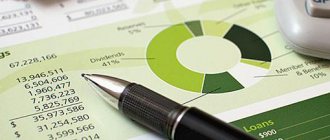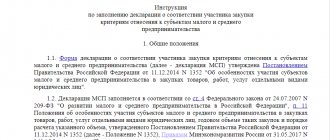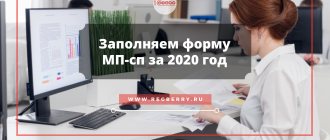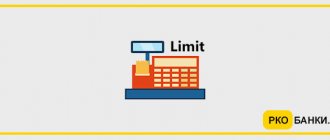Choosing the form of tax regime
Small businesses are given the opportunity to independently choose taxation, thanks to which newly created enterprises have comfortable and affordable conditions for their operation.
Small business, like any other legal business, is characterized by its versatility. In small enterprises, as well as in large ones, tax contributions to the state treasury have a significant share in the financial flows of the organization. Neglect of this aspect of doing business results in large financial losses for the company. Therefore, if you are just starting to work or want to optimize your expenses, contact a good accountant, or better yet, become one yourself.
Of course, we can admit that the tax system in the Russian Federation is imperfect, but a reasonable selection of the optimal tax payment method is quite possible.
Today, when creating a small enterprise, it is possible to choose one of several tax systems currently in force, most suitable for the company’s planned activities.
General mode
Taxation of enterprises of all forms of ownership and types is by default established in the form of a general regime - OSNO. Under this regime, the enterprise’s responsibility includes maintaining both accounting and tax records. If an organization works for OSNO, it pays the following taxes to the state:
- for added value,
- on organizations
- for profit (legal entities),
- on the income of individuals (individual entrepreneurs).
Advantages of OSNO
The advantages of this system include:
- the opportunity to engage in various types of activities, without having a limit on the amount of revenue;
- reimbursement of VAT from the budget for various reasons;
- greater attractiveness for counterparties due to the reimbursement of their VAT;
- possession of any number of employees and others.
Disadvantages of OSNO
The disadvantages of the general mode include:
- obligation to pay a large number of taxes,
- the obligation to provide a large number of reports to tax authorities and other government organizations,
- complex form of managing income and expenses,
- collection and mandatory storage of all documentation related to the activities of the enterprise and others.
Tax reporting
Tax reporting is separated from accounting or financial reporting, despite the fact that the bulk of it is submitted to the same authorities - tax authorities. Unlike accounting, tax reporting is prepared and submitted only to regulatory authorities. Participants (founders) of organizations and business owners, by and large, do not need it. The timing of this reporting varies widely. Reporting and tax periods for different taxes can be a month and a quarter, a half-year and a year.
The rules for submitting tax reporting are increasingly being changed and supplemented with amendments aimed at limiting paper reporting as much as possible. First, a limit on the number of employees was introduced. If a certain threshold was exceeded, it was necessary to submit declarations and settlements only via telecommunication channels. Then they began to gradually reduce the size of this threshold. Lawmakers have recently approached the issue from a different angle. Now there is a list of taxes, for which everyone (with rare exceptions) is required to report exclusively according to the TKS, using an electronic signature. The first among such taxes was VAT, for which you can submit a declaration for the 1st quarter of 2014 only in electronic form.
Small business in agriculture
Entrepreneurs whose activities include only the production of agricultural products and who do not process them have the opportunity to work under the Unified Agricultural Tax system.
In this case, collecting taxes from small businesses is much simpler, since the organization has the right not to pay the following types of taxes to the treasury:
- for profit (legal entities);
- on the income of individuals (individual entrepreneurs);
- on property;
- for added value.
If a company wants to work in this mode, it needs to show the share of all income from the sale of manufactured products in total sales revenue, and its share must exceed 70%.
Reporting is submitted every six months, the tax period is one year. Therefore, it should be remembered that having switched to the unified agricultural tax, it is impossible to change the taxation regime before the end of the tax year. However, under other systems, changing the regime is also difficult and is carried out only from the beginning of the year. Moreover, an application to change the form of tax collections must be submitted in advance within a strictly defined period.
Patent tax system
Previously, small businesses had the right to apply a simplified tax system, payments of which were calculated on the basis of a patent. Today, the provisions of the legislation have changed significantly - since 2013, a new independent regime has been introduced - the patent taxation system. Therefore, now the features of taxation of small businesses in terms of payment for the cost of a patent are differentiated from the taxation of business entities operating under other regimes, since under the new system it is necessary to pay only the cost of the patent.
The total patent amount is calculated at a rate of 6% of the company's estimated annual revenue. However, you should know that it can no longer be reduced, as before, by the amount of insurance premiums paid for compulsory insurance.
This regime can only be applied to individual entrepreneurs. In addition, patent taxation applies only to certain types of activities - the law specifies 69 of them, and this list is final. It should be remembered that when purchasing a patent for a period of less than 6 months, its full cost must be paid before the 25th day of the month after the start of its validity. If the patent is valid for a longer period, you can first pay for a third of it, and the remaining two-thirds closer to the end of its validity period - but no later than 30 days before its termination.
Unified tax on imputed income (UTII)
Taxes for small businesses changed significantly in 2013. Starting this year, as well as now, the transition to a single tax on imputed income has become voluntary. The calculation of UTII has also undergone changes - now it is calculated starting from the day of registration, based on the number of days that were actually worked in a given month.
It is calculated according to a formula that includes the amount of basic profitability established by the subject of the federation, coefficients that depend on the specifics of the enterprise and the tax rate. Online services will help you quickly calculate and pay taxes.
The maximum calculation of the number of hired personnel is calculated not as before, but from the average workforce. The number of employees, as before, should be no more than 100.
Advantages of UTII
Taxation of an enterprise's activities using UTII has the following advantages:
- exemption from paying the following taxes:
- for profit (legal entities);
- on the income of individuals (individual entrepreneurs);
- on property;
- for added value.
As noted earlier, the above taxes require maintaining rather complex accounting and tax records. Accordingly, replacing the specified number of tax payments greatly simplifies accounting and reduces document flow.
- ease of tax calculation;
- fixed tax amount;
- a tax that does not depend on the actual revenue of the enterprise, allows you to legally conduct business with various turnovers without fear of the tax authorities;
- ease of maintenance, simplicity of accounting for income and expenses.
Disadvantages of EVND
Features of collecting taxes from small businesses include the possibility of combining different taxation regimes, and this seemingly favorable opportunity, with UTII, turns into a significant disadvantage.
In this case, multi-industry enterprises are required to keep separate records for all types of activities, which significantly increases labor costs, since more detailed accounting of analytics is required. Accordingly, the number of taxes paid to the budget increases.
The disadvantages of this mode include the following:
- mandatory payment of a fixed amount, in the absence of the necessary revenue, may cause a loss to the enterprise;
- taxation of small businesses in Russia is imperfect, so there is confusion in the calculation of UTII in the regions.
Due dates
Documentation must be submitted by March 31 of the next reporting year, that is, by the end of the first quarter of the new year.
Moreover, if the last reporting day falls on a weekend or holiday, you must submit the documentation on the first working day after it.
Liability and fines
Filing reports is the same mandatory procedure as paying taxes; for late submission of documentation to the tax authorities, a fine of 5% of the amount of tax indicated in the tax return is imposed, and it cannot be less than 1,000 rubles.
In addition, a fine is imposed on the responsible persons individually - on the manager and accountant of the enterprise from 200 to 500 rubles for each document not submitted.
Failure to report to the Pension Fund is also subject to a fine of 5% of the amount of the last contributions for 3 months.
In the absence of a balance sheet, a fine is imposed in the amount of 200 rubles per document for the enterprise and in the amount of 300 - 500 rubles for responsible persons.
Failure to report to the statistical authorities will cost the culprit 3,000–5,000 rubles, while the responsible persons will receive a penalty of 300 to 500 rubles.
Simplified system (STS)
The most common tax regime is the so-called “simplified tax regime”. Like other special tax regimes, the simplified tax system is used by small businesses on a voluntary basis. But again, tax legislation has a number of restrictions for application in the simplified tax system.
Who cannot use the simplified tax system? So, these include:
- companies that have income for 9 months of more than 15,000,000 rubles;
- enterprises that earned more than 20,000,000 rubles during the year;
- the number of hired personnel should not exceed 100 people;
- the value of the property must be more than 100,000,000 rubles.
Advantages of the simplified tax system
Accordingly, as with other special regimes under the simplified tax system, an enterprise has the right not to pay the following taxes:
- for profit (legal entities);
- on the income of individuals (individual entrepreneurs);
- on property;
- for added value.
The specified tax payments are replaced by one, the calculation of which is chosen at the request of the enterprise.
Cons of the simplified tax system
No tax regime is ideal for doing business. Therefore, the currently popular simplified system also has disadvantages:
- loss of counterparties due to the impossibility of refunding VAT and the budget, which enterprises do not pay under the simplified tax system;
- restrictions on the range of subjects who have the right to choose the simplified tax system;
- a significantly limited list of expenses compared to OSNO when calculating the tax base;
- the obligation to pay the minimum tax even if the enterprise is unprofitable.
Thus, a simplified taxation system for small businesses may not always be beneficial for business development.
Balance sheet
The following information is automatically indicated in the header part of the balance sheet from the client’s registration card in the SBIS system:
- the date on which it is compiled;
- adjustment number (if the balance is primary, then “0” is indicated);
- name of the organization and TIN;
- code according to the classifier of enterprises and organizations (OKPO);
- code of type of economic activity (OKVED);
- code of organizational and legal form (OKOPF);
- the unit of measurement in which the balance sheet is compiled and its code (OKEY);
- address of the organization in accordance with the constituent documents.
The balance sheet consists of two sections: assets and liabilities. In these sections, for each line, indicators are reflected as of the reporting date, as well as at the end of the two previous years.
The balance sheet is filled in based on the balances of the accounting accounts:
| Indicator name | Line code | What is reflected | Reflection order |
| ASSETS | |||
| Tangible non-current assets | 1140 | Actual costs of searching, evaluating and exploring mineral deposits | Balance on account 08 (in terms of expenses for the development of small and medium-sized machines) – Balance on account 02 (in terms of depreciation and depreciation of small-scale machines) |
| 1150 | Residual value of fixed assets | Balance on account 01 – Balance on account 02 (excluding depreciation of objects accounted for on account 03) + Balance on accounts: 07, 08 (in terms of expenses for construction in progress) | |
| 1160 | Residual value of fixed assets intended to be provided for use for a fee | Balance on account 03 – Balance on account 02 (excluding depreciation of objects accounted for account 01 ) | |
| Intangible, financial and other non-current assets | 1110 | Residual value of intangible assets | Balance on account 04 (excluding R&D expenses) – Balance on account 05 (excluding R&D expenses) |
| 1120 | Expenses for completed R&D | Balance on account 04 (in terms of R&D expenses) – Balance in account 05 (in terms of R&D expenses) | |
| 1130 | Actual costs of searching, evaluating and exploring mineral deposits | Balance on account 08 (in terms of expenses for the development of legal acts) – Balance on account 05 (in terms of depreciation and depreciation of legal acts) | |
| 1170 | Financial investments with a circulation (repayment) period exceeding 12 months | Account balance: 55, 58, 73 (in terms of long-term investments) – account balance 59 (in terms of reserves for long-term investments) | |
| 1180 | Amount of deferred tax assets | Account balance 09 * | |
| 1190 | Other assets with a useful life of more than 12 months, not reflected in other lines of this section | Account balance: 07, 08 (excluding expenses for construction in progress) + Account balance: 15, 16 (in terms of equipment for installation) + Other account balance | |
| Reserves | 1210 | Cost of inventories | Account balance: 10, 11, 15 (except for amounts reflected on line 1190) 20, 21, 23, 28, 29, 41, 43, 44, 45, 97 – Account balance: 14, 42 + (-) Balance on account 16 (except for amounts reflected on line 1190) |
| Cash and cash equivalents | 1250 | Balance of cash and cash equivalents | Account balances: 50, 51, 52, 55 (except for amounts reflected on lines 1170 and 1240), 57 |
| Financial and other current assets | 1220 | VAT amounts presented by suppliers and not accepted for deduction | Account balance 19 |
| 1230 | Amount owed by various debtors | Debit account balance: 60, 62, 68, 69, 70, 71, 73, 75, 76 – Account balance 63 | |
| 1240 | Financial investments whose circulation (repayment) period does not exceed 12 months | Account balance: 55, 58, 73 (in terms of short-term investments) – account balance 59 (in terms of reserves for short-term investments) | |
| 1260 | Other current assets not reflected in other lines of this section | Debit balance on accounts: 45, 76 (in terms of VAT), 19, 68 (in terms of excise taxes), 94 + Balance in other accounts | |
| BALANCE | 1600 | The cost of all property of the organization | Sum of all balance sheet asset lines (calculated automatically) |
| PASSIVE | |||
| Capital and reserves | 1310 | The amount of authorized capital reflected in the constituent documents | Account balance 80 |
| 1320 | The cost of shares (shares) purchased by the company from shareholders (participants) | Account balance 81 | |
| 1340 | Amount of additional valuation of non-current assets | Account balance 83 (in terms of revaluation of fixed assets) | |
| 1350 | Amount of additional capital | Account balance 83 (excluding revaluation) | |
| 1360 | Amount of reserve capital | Account balance 82 | |
| 1370 | Amount of retained earnings (uncovered loss) | Account balance 84 | |
| Long-term borrowed funds | 1410 | Debt on long-term (over 12 months) loans and borrowings | Account balance 67 |
| Other long-term liabilities | 1420 | Amount of deferred tax liabilities | Account balance 77 |
| 1430 | The amount of reserves created for events that will occur no earlier than in a year | Account balance 96 (in terms of obligations whose maturity exceeds 12 months) | |
| 1450 | Other liabilities with a maturity period of more than 12 months, not reflected in other lines of this section | Account balance: 60, 62, 68, 69, 73, 75, 76, 86 (in terms of long-term liabilities) | |
| Short-term borrowed funds | 1510 | Debt on short-term (up to 12 months) loans and borrowings | Account balance 66 |
| Accounts payable | 1520 | Amount of short-term debt to creditors | Account credit balance: 60, 62, 68, 69, 70, 71, 73, 75, 76 |
| Other current liabilities | 1530 | Income received in the reporting period, but related to subsequent periods | Account balance 98 + Account balance 86 (in terms of budget financing, grants, etc.) |
| 1540 | The amount of reserves created for events that occur during the year | Account balance 96 (in terms of obligations whose maturity does not exceed 12 months) | |
| 1550 | Other liabilities with a maturity of up to 12 months, not reflected in other lines of this section | Account balance: 76, 86 (in terms of other short-term liabilities) | |
| BALANCE | 1700 | Sum of all funding sources | Sum of all liability lines on the balance sheet (calculated automatically) |
* — Lines are filled in if the organization - a small business entity applies PBU 18/02.
** — The amount of loss on line 1370 is indicated with a minus sign.
Features of the simplified mode
Taxation of small businesses under a simplified system is carried out on two objects.
The first is the total income of the enterprise. The tax payment in this case is 6% of the income.
The second is the difference between income and expenses. In this case, the tax burden will be 15% of the difference received.
Entrepreneurs have the right to choose any of these objects for taxation, but first it is necessary to calculate the costs of the enterprise. To find out which object is more profitable for the organization.
Replacing basic taxes with a single one does not relieve small business representatives from other responsibilities to the state, such as:
- regular provision of tax and statistical reporting;
- payment of other taxes depending on the conduct of business: for the use of water resources, for the extraction of minerals, etc.;
- payment of excise taxes if the entrepreneur sells excisable goods;
- payment of other fees, such as deductions and contributions to extra-budgetary funds - Pension Fund, Social Insurance Fund. So, if a private entrepreneur pays a fixed amount for himself to the pension fund once a year, then he must make contributions monthly for his employees.
What you need to know about taxes?
The size and number of tax fees depends on the form of ownership of the company and the chosen taxation system:
The general taxation system (OSNO) is the most expensive and complex system, suitable for legal entities and individual entrepreneurs. Selected by default if the taxpayer has not submitted an application to switch to another system. OSNO is most often used by medium and large businesses. If the turnover is more than 60 million rubles per year and/or the staff is 100 or more people, then the company is obliged to switch to OSNO.
The simplified taxation system (STS or simplified taxation system) is the most common system among small businesses. There are 2 types of simplified tax system: “simplified 6%” and “income minus expenses”.
- “Simplified 6%” - company income is taxed at 6%
- “Income minus expenses” - a tax of 15% is levied on the difference between income and expenses, that is, on profit
The Unified Agricultural Tax (USAT) - in meaning repeats the “simplified income minus expenses”, but applies only to agricultural activities. Tax 6% on profit.
Unified tax on imputed income (UTII) - intended for activities that provide services to the population (each region has its own lists of services subject to UTII). The tax is 15% of profits predicted in advance based on business performance. In this case, you will have to pay the tax in full regardless of the company’s actual income.
Under UTII, you can only work with individuals; you cannot enter into contracts with legal entities - and this narrows business opportunities. Examples of companies on UTII are small hostels, studios, workshops, and small retail trade. The maximum area is up to 150 square meters and the staff is up to 100 people.
Patent (PSN) - according to this system, the tax amount is 6% of the amount of potential annual income - it can be found out for each type of activity in any region using the Federal Tax Service calculator.
Only individual entrepreneurs with a staff of up to 15 people, managing an area of no more than 50 sq.m. can work on a patent. The patent is valid from 1 to 12 months - the period is determined by the taxpayer in the application for the transition to the PSN. Next you will need to buy a new patent.
Patents work only in the territory of their region and district. If you want to expand, buy a new patent, the cost depends on the region. Coffee shops, hairdressers, market traders, various workshops, tire shops, etc. usually operate on the patent.
| Tax regime | Base | VAT* | Property tax | Nominal rate | General characteristics of the taxation system |
| BASIC | Profit | Eat | Eat | 20% for legal entities 13% for individual entrepreneurs | Flexible |
| USNO 6% | Income | No | No | 6% | Flexible |
| simplified taxation system 15% | Income minus expenses | No | No | 15% | Flexible |
| Unified agricultural tax | Income minus expenses | No | No | 6% | Flexible |
| UTII | Imputed income | No | No | 15% | Inflexible |
| Patent | Potential income | No | No | 6% | Inflexible |
Most small businesses prefer the LLC and “simplified” form of ownership, so the rest of the article will be devoted to it. If you have a different taxation system, then you can read about this in the People’s Accounting Wikipedia, as well as in a special section on the website of the Federal Tax Service.






